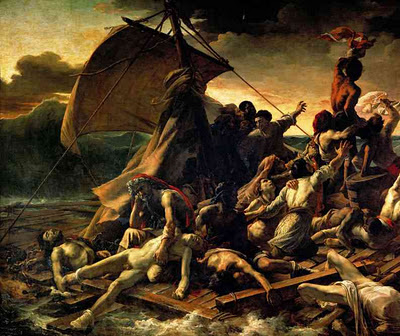The painting assignments in this class do not assume you
have had prior painting experience.
If you follow these steps and do not rush the process, you should be
able to produce quality technical application of the media.
Almost all painting assignments will be done on white
cold-pressed illustration board with heavy-body acrylic paints.
1. Preparing Your Surface: After your initial pencil drawing on your board, apply a thin layer of acrylic matte medium over the entire surface (this helps the paint adhere to the board and makes it easier to remove tape). Let dry. Tape off a border around
the painting area on your board with Scotch Blue tape. After the painting is completed, remove the tape for a crisp edge all around.
2. Mixing your paint: use a palette knife to fully and
cleanly mix colors on your palette (using a brush can often lead to un-mixed
colors and makes cleaning your brushes more difficult). Make sure you mix enough of each color.
3. Applying Your Paint: use a damp brush loaded with
paint and apply thinly to the illustration board. Try to avoid using too much paint, as this will result in
visible brushstrokes on your surface.
Use a flat brush (square shape) for larger areas of color, and use your
detail brushes (liner or round) for small areas. You will probably have to paint 2 coats of each color
to achieve an opaque, flat surface.
Wait for each coat to fully dry before proceeding with the next one.
4. Achieving Sharp Edges: use your Scotch Magic Tape
to tape off precise edges that you cannot freehand. Lay the tape down over the area that needs to be masked
off. If it is not a straight edge,
use your xacto knife to cut along the line. Gently rub the tape down onto the surface to make sure paint
does not escape underneath the tape (make sure you don’t tape over paint that
is still drying!). When you apply
the paint, paint over the tape and away from it so you aren’t pushing paint up
to the edge, but away from it.
Repeat as necessary for all edges.
5. Allow for Drying Time: acrylic paint dries fairly
quickly. Once it has started to
dry (tacky to the touch) you should not paint over it again until it is fully
dry. If you do, you will risk
pulling up the paint you have already put down, leaving an uneven surface. Instead, move on to another area of the
painting that is fully dry and return to the original area when it is dry to
the touch.
6. Use of Water: starting a painting with thinned down
acrylic paint (i.e. mixing with water) is acceptable. However, water will thin, lighten and dull the acrylic
pigment. You should eventually use
paint with less water added (a dampened brush is advisable). Once you have a substantially painted
surface, you should not paint a wash over it as this may affect the acrylic’s
binding properties.
7. Keeping Paint on Your Palette Wet: since acrylic
paint dries quickly, you may need to spray water onto your palette if you are
working with the same color for a long period of time. Do not put more paint than you need
onto your palette as it may dry before you can use it. You can also put your mixed colors into
small plastic or glass, sealed containers if you want to re-use them at a later
time. This is advisable for colors
that you have mixed and need to use again, as it is very difficult to re-mix an
exact color match.
Remember, your finished paintings should have a smooth
surface, sharp edges within the painted area, well-mixed colors, and a clean
border around it.



























































